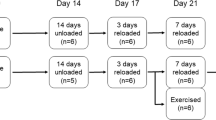Abstract
Rehabilitation didn't get much attention in animal research as compared to disuse atrophy that has been widely investigated over the years. We therefore performed a combined morphometrical and biochemical study on the effect of recovery from hind-limb immobilization on the tibia and the serum of rats. The experiments were carried out on 42 young Sprague-Dawley male rats. In one group of 32 rats the left hind-limb was immobilized for 2 weeks and then remobilized for another 2 weeks. Another group of 10 rats served as controls. Total body weight was partially restored. Tibia weight (fresh, dry and ash) showed on the other hand no tendency to improve. Serum triglycerides, urea, creatinine, albumin and calcium that were found to be reduced during immobilization returned to normal values during the rehabilitation period. Serum phosphorus that remained normal during limb disuse rose to above normal values in the remobilization phase. Serum alanine aminotransferase levels changed from low to normal. Serum alkaline phosphatase showed a rebound phenomenon from low to above-normal. Both muscle aspartate aminotransferase and bone alkaline phosphatase that were low during immobilization returned to normal in response to rehabilitation. We conclude that biochemical alterations are fast and tend to become fully corrected. Overcoming weight loss is a much slower process and it is unclear whether weight ever returns to pre-atrophic values.
Similar content being viewed by others
References
Berg HE, Dudley GA, Haggmark T, et al. Effects of lower limb unloading on skeletal muscle mass and function in humans. J Appl Physiol 1991;70:1882–5.
Davies CT, Sargeant AJ. Effects of exercise therapy on total and component tissue leg volumes of patients undergoing rehabilitation from lower limb injury. Ann Human Biol 1975;2:327–37.
Elsasser U, Ruegsegger P, Anliker M, et al. Loss and recovery of trabecular bone in the distal radius following fractureimmobilization of the upper limb in children. Klin Wochenschr 1979; 57:763–7.
Gebhard JS, Kabo JM. Meals RA. Passive motion: the dose effects on joint stiffness, muscle mass, bone density and regional swelling. J Bone Joint Surg [Am] 1993;75:1636–47.
Kiviranta I, Tammi M, Jurvelin J, et al. Articular cartilage thickness and GAG distribution in the young canine knee joint after remobilization of the immobilized limb. J Orthop Res 1994;12:161–7.
Kroese AJ. The effect of inactivity on reactive hyperaemia in the human calf. Scand J Clin Lab Invest 1977;37:53–8.
Li XJ, Jee WS, Chow SY, et al. Adaptation of cancellous bone to aging and immobilization in the rat. Anat Rec 1990;227:12–24.
Mc Nulty AL, Otto AJ, Kasper CE, et al. Effect of recovery mode following hindlimb suspension on soleus muscle composition in the rat. Int J Sports Med 1992;13:6–14.
Palmoski M, Perricone E, Brandt KD. Development and reversal of a proteoglycan aggregation defect in normal canine knee cartilage after immobilization. Arthrit Rheum 1979;22: 508–17.
Sanchez J, Sarue AM, Brunet A, et al. Enzymatic adaptations to treadmill training under the influence of naftidrofuryl acid in diaphragm and limb muscles of old rats. Arch Int Physiol Biochim Biophys 1991;99:129–34.
Tucker KR, Seider MJ, Booth FW. Protein synthesis rates in atrophied gastrocnemius muscles after limb immobilization. J Appl Physiol 1981;51:73–7.
Author information
Authors and Affiliations
Rights and permissions
About this article
Cite this article
Cohen, I., Chechick, A., Bogin, E. et al. Recovery from a state of limb hypokinesia in the rat. Unfallchirurgie 25, 71–77 (1999). https://doi.org/10.1007/BF00579684
Accepted:
Issue Date:
DOI: https://doi.org/10.1007/BF00579684




